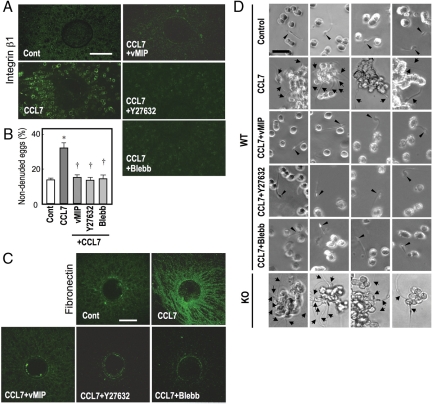Figure 4.
CCL7 strengthens the cumulus ECM through the Rho/ROCK/actomyosin pathway. The ampulla containing COCs were incubated with CCL7 in combination with vMIP-II (vMIP), Y27632, and blebbistatin (Blebb), and the COCs were excised and analyzed as follows: A, Surface accumulation of integrin-β1 in CCL7-treated cumulus cells. The COCs were stained with an FITC-labeled antimouse integrin-β1 antibody in a nonpermeabilized condition. Scale bar, 100 μm. B, CCL7-induced hyaluronidase resistance in the cumulus ECM. The COCs were subjected to 0.01% hyaluronidase treatment. *, P < 0.01 (vs. Cont); †, P < 0.01 (vs. CCL7 only). C, CCL7-induced formation and assembly of fibronectin fibrils in the cumulus ECM. The COCs were incubated with a rabbit antifibronectin antibody and detected with an Alexa488-conjugated antirabbit IgG antibody. Scale bar, 100 μm. D, CCL7-induced incomplete disassembly of the cumulus ECM and sperm capture by the cumuli during IVF. COCs were incubated with sperm, and their scattering and interaction with sperm were examined. In control COCs, individual cumulus cells were scattered and sperm passed between the cells (arrowhead). In CCL7-treated COCs, cumulus cells remained in clusters and a number of sperm (arrows) were captured by cumulus cells. Both of the effects of CCL7 were suppressed by vMIP-II, Y27632, and blebbistatin. Four different sperm were examined for control, CCL7+vMIP, CCL7+Y27632, CCL7+blebbistatin, and four different fields were captured for CCL7-treated and Ptger2−/−(KO) COCs. Representative results of three independent experiments are shown.

